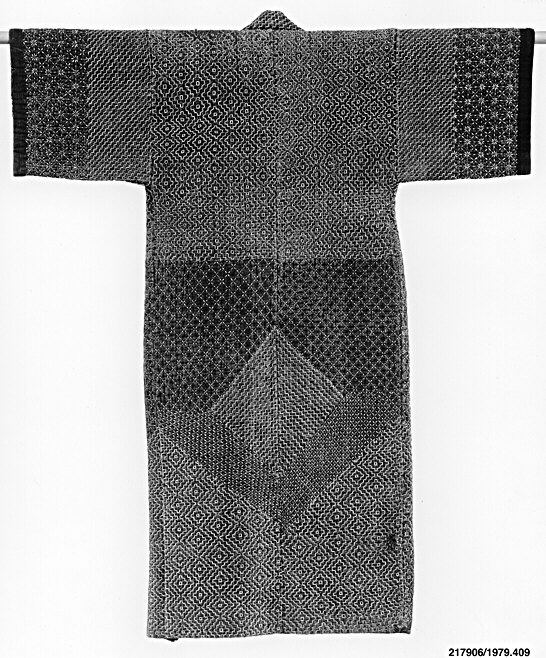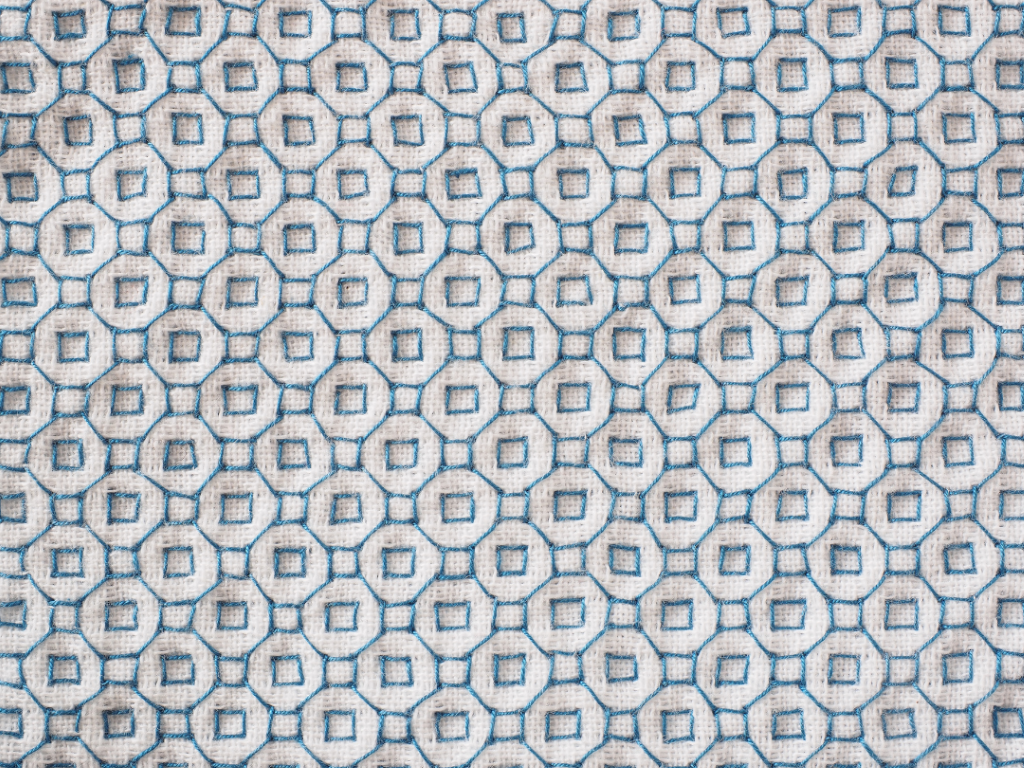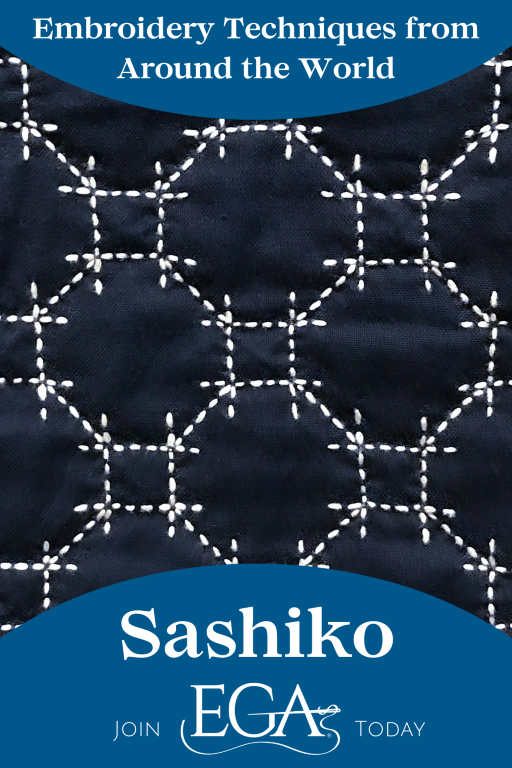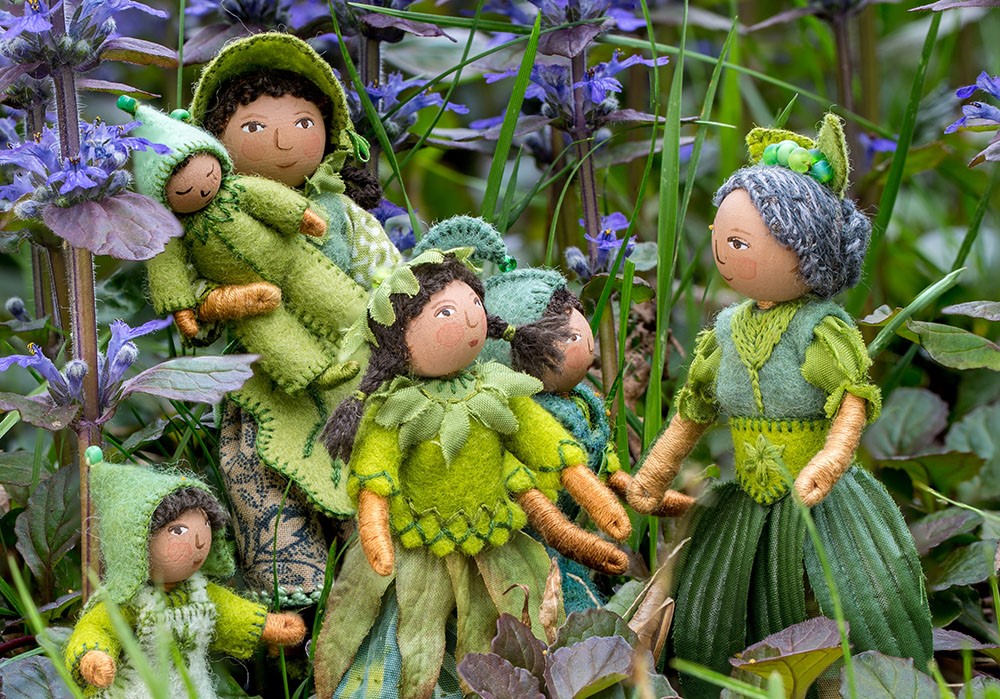Technique: Sashiko
Place of Origin: Japan
Earliest approximate date: 1600s
History: The word sashiko derives from the Japanese verb sasu, which means “to pierce; to stab; to stick; to prick.” Sashiko, then, literally translates to “little stabs.”
While sashiko has evolved into a decorative technique for many of today’s embroiderers, it began as a method of extending the life of textiles. Boro, short for boroboro, which translates to “tattered,” is a Japanese mending and patchwork technique. Boro and sashiko are related practices. Boro refers to the remnant textiles themselves as well as the process of creating new reinforced fabrics from scraps; sashiko refers to the decorative stitches featured on the textiles and holding the textiles together.

Sashiko’s roots as a visible mending technique were born of necessity. Arising during the Edo Period (1603-1868), Japanese women from fishing and farming communities stitched sashiko to repair and reinforce clothing to make it thicker, warmer, and more durable. Sashiko featured in many fisherman’s jackets, as well as firefighter’s jackets. For firefighter jackets, stitchers would stitch together multiple layers of fabric that could be made wet and thereby further protect firemen from the heat of raging fires. (See a fireman’s hat with sashiko at The Met Museum here).

During the Edo Period, class hierarchy dictated the use of textiles.Those belonging to the upper classes had the luxury of fine silks at their disposal, while those in the lower classes could only use fibers like hemp, and eventually cotton. It was difficult to create warm fabrics for severe winters; sashiko and boro offered the ability to create multi-layer fabrics to battle the cold.
In addition, industrialized textile production was not introduced to Japan until the late 1800s; before that, linen, hemp, and cotton cloth were grown, spun, woven, and dyed by hand. As a result, it was an absolute necessity to develop a method for reusing and mending fabric. Every piece of fabric was precious, and tattered or torn cloth was recycled rather than thrown away.

Materials, Techniques, and Stitches:
Sashiko is usually done with white thread on indigo-dyed fabric. Sashiko thread is thicker, twisted from several finer threads to create a stronger thread. Sashiko needles usually have larger eyes to accommodate the thicker thread. The stitchwork itself is said to resemble snow on the ground in winter. Sashiko consists of running stitches, and designs can feature a single repeating motif, or several repeating motifs grouped together.

There are two primary styles of sashiko: moyōzashi and hitomezashi. In moyōzashi, long lines of running stitches form patterns. In hotemezashi, designs are smaller, more dense, and the resulting repeating pattern often resembles weaving. The natural world and geometric shapes inspired many sashiko patterns. Ocean waves, grass, persimmon flowers, circles, triangles, squares, stripes, and diamonds, fish scales and fishing nets, bird’s feathers and more inspired the creation of sashiko designs.

Are you interested in exploring more sashiko designs? Check out our introduction to visible mending and explore our Asian Fusion online gallery.

Sources
Shaver, Cynthia, “Sashiko: A Stitchery Of Japan” (1992). Textile Society of America Symposium Proceedings. 584. https://digitalcommons.unl.edu/tsaconf/584
Boro. (2021, July 17). In Wikipedia. https://en.wikipedia.org/wiki/Boro_(textile)
Sashiko. (2024, January 8). In Wikipedia. https://en.wikipedia.org/wiki/Sashiko
Paray, J. (2022). The Art Of Sashiko: The Fascinating History Of Sashiko. Independently Published.
(n.d.). Short History of Japanese Textiles. Kimono Boy. https://www.kimonoboy.com/short_history.html#:~:text=By%20the%201870s%2C%20the%20Japanese,weaving%20mills%20operated%20near%20Osaka.
(n.d.). The Collaboration of Culture and Textiles in Edo and Meiji Japan. Between the Warp and Weft. https://betweenthewarpandweft.wordpress.com/japanese-textiles-research-project/
(n.d.). What is Sashiko? 8 Things to Know About Japanese Embroidery. Japan Objects. https://japanobjects.com/features/sashiko



